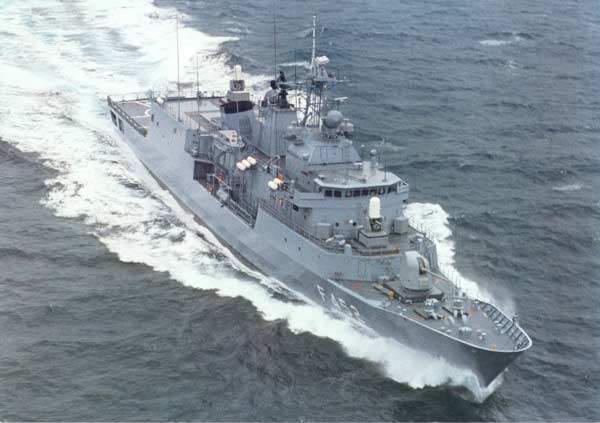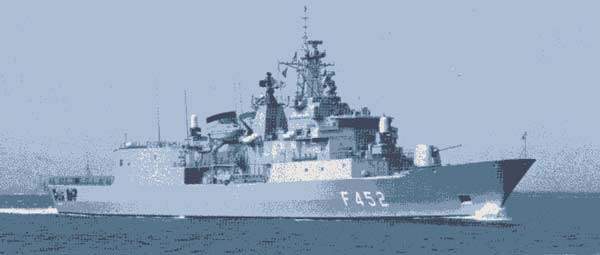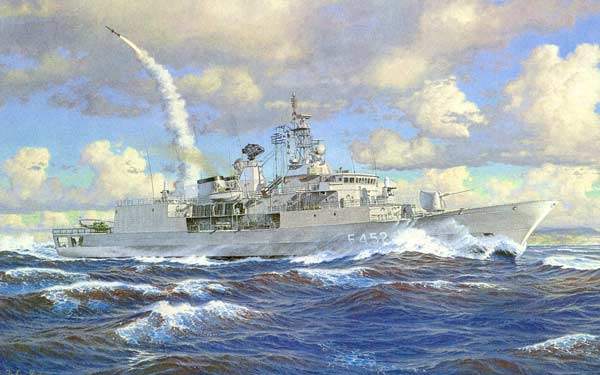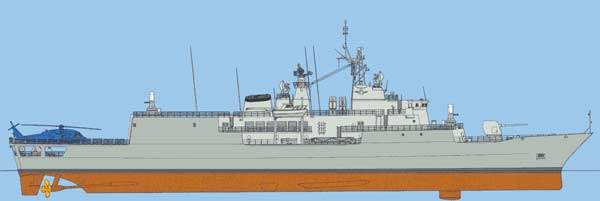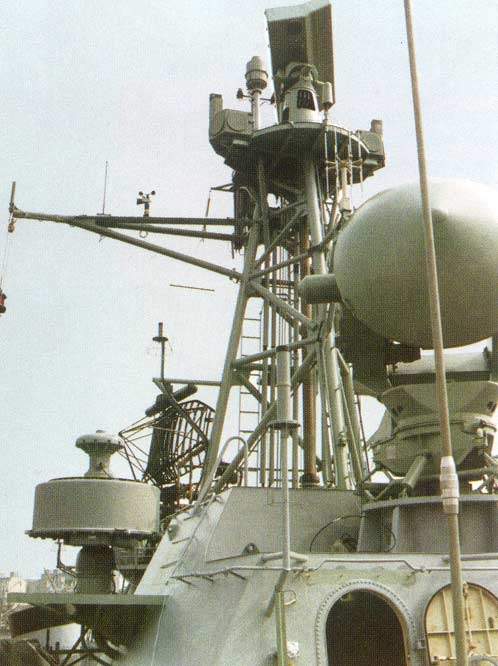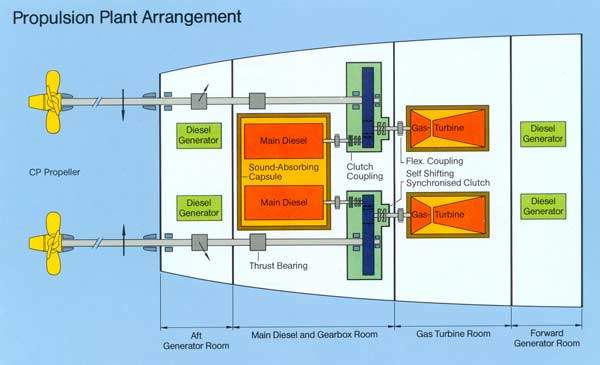The four Hydra class frigates of the Hellenic Navy of Greece are 3,200t frigates of the MEKO 200HN design. The first of the four, Hydra (F452) was built by Blohm and Voss in Hamburg and commissioned in November 1992. The other three were constructed at the Hellenic Shipyards at Scaramanga. HS Spetsai (F453) was commissioned in October 1996, HS Psara (F454) in April 1998 and HS Salamis (F455) in December 1998.
Three Hydra Class frigates were deployed in support of Operation Enduring Freedom in 2002-2003.
Design
The MEKO frigates have high-level specifications for shock resistance, stiffness requirements for the fire control and radar systems, and blast and gas pressure resistance to retain the integrity of the on-board weapon systems. The hull is constructed of high tensile steel with a yield strength of 355 N/mm².
The ship is divided into 12 self-sufficient watertight sections, which function almost independently of each other. Each compartment also has independent data transfer to the ship’s naval automation system, Nautos.
Command and control
The ship’s battle management system is the Thales Nederland (formerly Signaal) STACOS Model 2 command and control system. The ship is equipped with a multi-interface computer equipment / data information link (MICE/DAIL) system. A network management console installed in the ship’s combat information centre monitors the activities of the DAIL bus.
Hydra missiles
The ship’s surface-to-surface missile system consists of two AN/SWG-1A(V) four-cell launchers for the Boeing Harpoon missile. Harpoon is equipped with semi-active radar homing and has a range to 130km. The launchers are installed at a fixed elevation on the upper deck behind the main mast.
The ship’s surface-to-air missile is the Nato Sea Sparrow supplied by Raytheon. The mk48 mod 2 vertical launchers for 16 missiles are installed aft of the two funnels. The missile uses semi-active homing to a range of 15km.
In May 2007, Thales was awarded a contract to upgrade the STIR fire control system to allow the firing of the evolved Sea Sparrow missile (ESSM). HS Salamis has been upgraded and, in August 2008, successfully completed a live firing test. HS Spetsai was tested in 2009 and HS Hydra successfully completed a live firing test in February 2010.
Torpedoes
The ship’s anti-submarine warfare system consists of two triple 324mm torpedo tubes, mk32 mod 5, installed on the port and starboard sides of the ship at the main deck level forward of the masts. The ship is armed with Honeywell mk46 anti-submarine torpedoes, with active and passive homing and a range of 11km.
Guns
The main gun, installed at the bow, is the FMC 127mm mk45 mod 2A gun. The ship has two General Dynamics / Raytheon Phalanx mk15 mod 12 close-in weapons systems, one on the raised gun deck forward of the bridge above and behind the main gun, and one on the roof of the hangar at the stern of the ship. Each Phalanx gun has six barrels firing 3,000 rounds a min and a range to 1,500m.
Countermeasures
The ship’s torpedo decoy is the Nixie AN/SLQ25. Four SuperRBOC chaff launchers, mk36 mod 2, are installed on the raised gun deck.
The ship’s electronic warfare suite includes the Argo AR700 electronic support measures and an Argo APECS radar jamming systems.
Aircraft
The ship accommodates a single 10t class helicopter such as the Sikorsky S-70B-6 Aegean Hawk. The Aegean Hawk is armed with two mk46 torpedoes for the anti-submarine role and the Kongsberg Penguin mk2 mod 7 anti-ship missile.
Sensors
The Thales Nederland DA08 FFT long-range air and surface F band radar is installed high on the main mast. The medium-range Thales Nederland MW08 F to G-band air search radar is on the mast tower in the centre of the ship forward of the funnels.
The distinctive conical antennae of the Thales Nederland STIR fire control radar, operating at I, J and K bands, are installed one facing the bow about half way up the main mast, just forward of the air search radar, and one facing the stern just below the air search radar on the mast tower. Racal supplied the ARPA26890 BT navigation radar operating at I band.
The ship is fitted with the Raytheon SQS-56 DE 1160 sonar system.
Propulsion
The Hydra Class ships are fitted with a twin-screw propulsion system. Each shaft line consists of an MTU diesel engine, model 20V956TB82 with a power output of 3,830kW, a General Electric gas turbine, model LM2500-30 with a power output of 22,300kW, a reduction gearbox with clutch coupling and an SSS clutch driving an Escher Wyss controllable pitch propeller. Control and monitoring of the propulsion is performed via the Siemens Nautos databus and video system.
The Global Naval Surface Combatants and Warfare Systems Market 2011-2021
This project forms part of our recent analysis and forecasts of the global naval surface combatants and warfare systems market available from our business information platform Strategic Defence Intelligence. For more information click here or contact us: EMEA: +44 20 7936 6783; Americas: +1 415 439 4914; Asia Pacific: +61 2 9947 9709 or via email.

